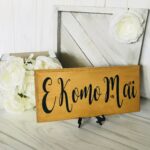Barbie’s First Dreamhouse: A Cardboard Time Capsule
Remember the iconic Barbie Dreamhouse? Before it transformed into the pink palace we know and love today, it started with a much different vibe. Journey back to 1967, where Barbie’s digs were as groovy as a vintage record store!
Cardboard Cool: A Peek into the Past
Forget the plastic fantastic of today’s Dreamhouses – the original 1967 model was all about chic cardboard construction. Like the ultimate pop-up playset, it folded up neatly for easy storage. The bold plaids and wood grain patterns were straight out of a mod magazine, perfectly capturing the swinging sixties’ design trends.
More Than Just a Toy: Reflecting a Cultural Shift
This wasn’t your grandma’s dollhouse (unless your grandma was a total trailblazer!). The 1967 Dreamhouse likely represented a cultural shift, a time when women were breaking free from traditional roles and embracing their independence. Barbie, with her own pad and a world of possibilities, was a symbol of this changing landscape.
From Cardboard to Castles: The Evolution of a Dream
The Dreamhouse has gone through some serious renovations over the years. We’re talking about a journey from those humble cardboard beginnings to the multi-story mansions you see today – it’s like watching a real estate reality show, but for dolls! Architectural Digest even did a video about it. But you know what? That 1967 version still holds a special place in the Dreamhouse hall of fame.
A Collector’s Dream: The Hunt Is On!
For vintage toy enthusiasts, the 1967 Barbie Dreamhouse is the holy grail. Its retro charm and historical significance make it a highly sought-after item. Websites like eBay and Antique Trader are like digital treasure maps, giving you a glimpse of where to find these nostalgic gems and how much they might cost. Spoiler alert: a mint condition one could be worth a pretty penny!
Then and Now: Reflecting on the Dream
What’s fascinating is how different the 1967 Dreamhouse is from its modern counterparts. It makes you think about how our ideas of a “dream home” have changed over time. The minimalist design, affordable price tag, and focus on pure imagination offer a unique perspective on evolving consumerism and what we value in a home, whether we’re dolls or actual humans.
Let’s Talk!
- Think back to the 1960s – how did the Dreamhouse reflect the social changes happening then?
- Why do you think the 1967 version is so special to collectors today?
- What can we learn from comparing the original Dreamhouse to the ones we have now?
Outperforming the Competition: Barbie Dream House Costs in the 1960s
Ever wonder what it cost to give Barbie her first taste of homeownership back in the groovy 1960s? Let’s take a trip down memory lane and explore the price tag of the iconic Dreamhouse.
A Dream for a Dime: In 1962, the very first Barbie Dream House hit the shelves for a mere $8, which, accounting for inflation, translates to roughly $70 in today’s money. This relatively affordable price tag made the Dreamhouse an accessible aspiration for young dreamers.
Cardboard Castles: It’s hard to imagine now, but those early Barbie Dream Houses were primarily constructed from printed cardboard! This material choice reflects both the design trends and affordability concerns of the 1960s. Cardboard was lightweight, inexpensive, and perfect for creating those colorful, mod designs that scream “1960s.”
Investment in Pink: While a steal in the 1960s, pristine condition vintage Barbie Dream Houses can now fetch hundreds, even thousands, of dollars at auction! This surge in value proves their enduring appeal to collectors and serves as a reminder of the nostalgia associated with these iconic toys.
Barbie Dream House Launch Year: A Timeline of Dreams
Curious about the exact year the Barbie Dreamhouse first graced toy shelves? The answer might surprise you! It wasn’t some grand mansion that marked the beginning of this iconic playset – it was a humble cardboard fold-out studio that first launched in 1962.
Think about it: the 1960s were all about keeping things sleek and modern, and those early cardboard Dreamhouses perfectly captured that aesthetic! Fast forward to today, and we’ve got Dreamhouses with working elevators and swimming pools. Over the years, the Dreamhouse has mirrored how our world has changed, especially when it comes to architecture and even how women are seen in society.
The Dreamhouse represents more than just a toy; it’s a little world where kids can let their imaginations run wild. For generations, it’s been a powerful symbol of independence, representing the freedom of having your own space and making it your own. And of course, it taps into those classic dreams of having a beautiful home and family.
If you happen to have an old Dreamhouse tucked away somewhere, especially one from those early days in the 1960s and in good condition? Hold onto it! Those vintage Dreamhouses are super collectible these days, with some collectors willing to shell out big bucks for them at auctions.
A Glimpse Inside: What Did the 1962 Dream House Look Like?
Imagine stepping back in time to 1962, the year the very first Barbie Dreamhouse made its debut. This wasn’t the sprawling pink mansion of today; this Dreamhouse was a study in minimalist chic, reflecting the popular ranch-style homes of the time. But what exactly did it offer a fashion icon like Barbie?
Crafted from cardboard, this stylish pad prioritized portability and imagination over extravagant features. Instead of a walk-in closet or gourmet kitchen, Barbie had the essentials: a comfy bed, a trendy TV, some chic bookshelves, and a closet—complete with tiny plastic hangers!—perfect for a fashionista on the go.
This first Dreamhouse wasn’t about luxury; it was about sparking imagination. Its compact size made it easy for little ones to fold up and carry around, creating their own Barbie adventures wherever they went. This cardboard creation suggests that even back then, Barbie’s world was all about fun, fashion, and making dreams a (playful) reality!
How Many Dreamhouses Has Barbie Owned? Unveiling the Numbers
Believe it or not, Barbie has moved a LOT! Over the years, Mattel has released a staggering total of 43 different Dreamhouses, each one reflecting the trends and dreams of different generations.
From the humble cardboard creation of 1962, which cost a mere $5, to the high-tech marvels of today, the evolution of Barbie’s Dreamhouse has been nothing short of extraordinary.
As Barbie took on new careers and explored different passions, her Dreamhouse transformed right alongside her. There were trendy apartments for the fashionista Barbie, spacious mansions for the family-oriented Barbie, and everything in between.
Each new Dreamhouse mirrored the dreams of young girls growing up in those times. It’s fascinating to see how architectural styles, interior design, and even technology found their way into these playsets. Some experts believe the Dreamhouse played a role in shaping those aspirations too! By giving kids a glimpse into different possibilities, the Dreamhouse sparked imaginations and inspired countless hours of make-believe.
And hey, if you’re lucky enough to have an old Dreamhouse tucked away in the attic, hold onto it! Vintage Dreamhouses are super collectible these days and can be worth a pretty penny. It’s amazing to think a simple toy can hold so much history and sentimental value, right?
Don’t forget to explore these other fascinating articles:
Interested in Muggsy Bogues Slam Dunk? Unveil the amazing story of the shortest NBA player to ever dunk!
Curious about Wilt Chamberlain’s Age 1974? Explore the legendary center’s incredible performance at the age of 47.
Unsure about How to Pronounce Samhain? Gain clarity on the proper pronunciation of the ancient Celtic festival.
- E Komo Mai: Unlocking the True Meaning and Cultural Significance of Hawaiian Welcome - December 22, 2024
- Decoding the WC & Beyond: A Guide to European Restroom Signs & Lingo - December 22, 2024
- Is Dopebox Down?The Best Free & Legal Dopebox Alternatives for Streaming and Storage (2024) - December 22, 2024
















